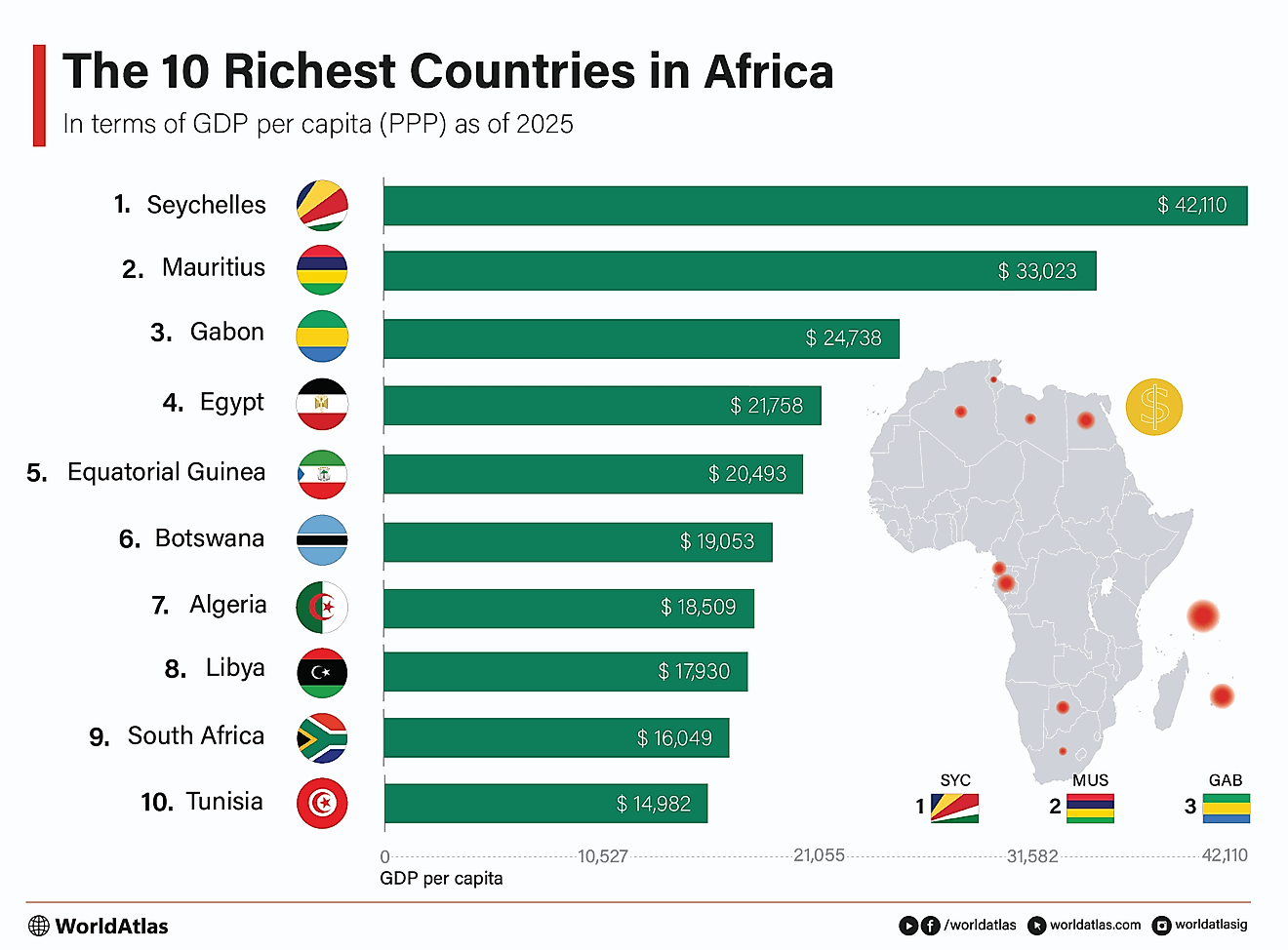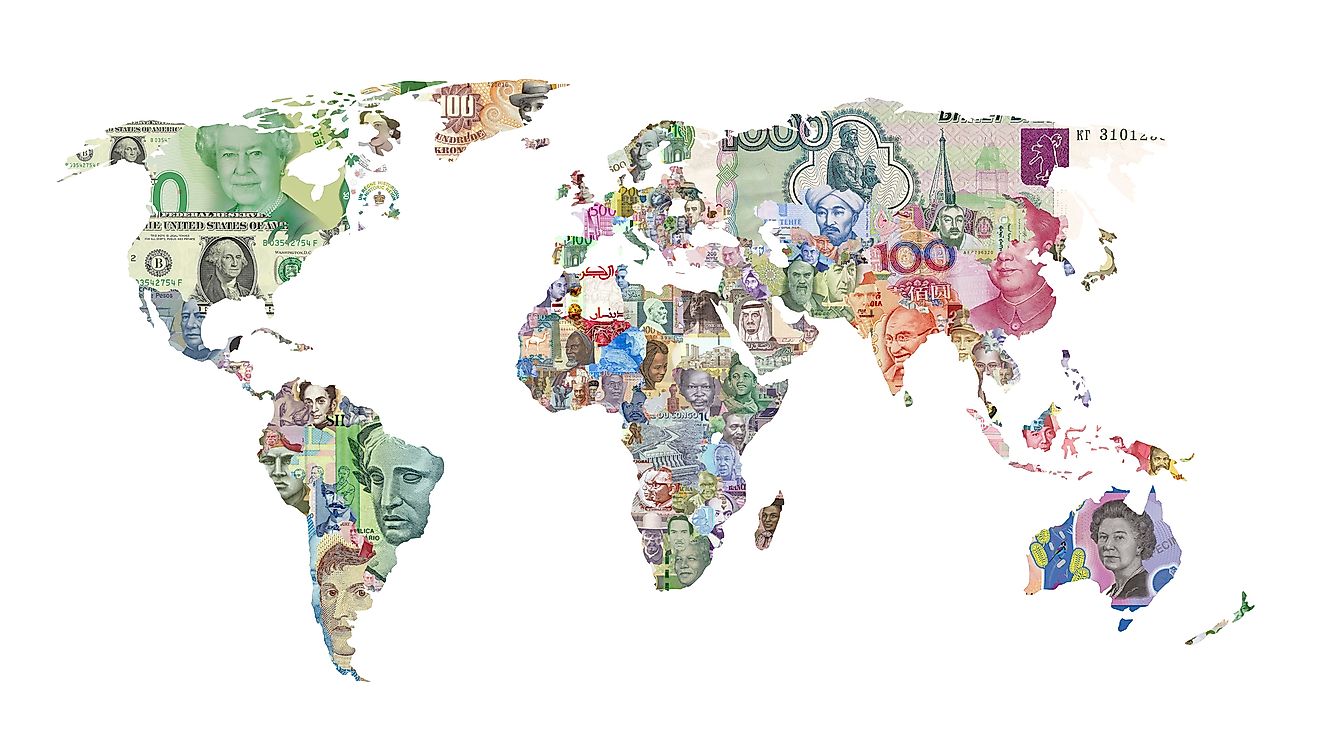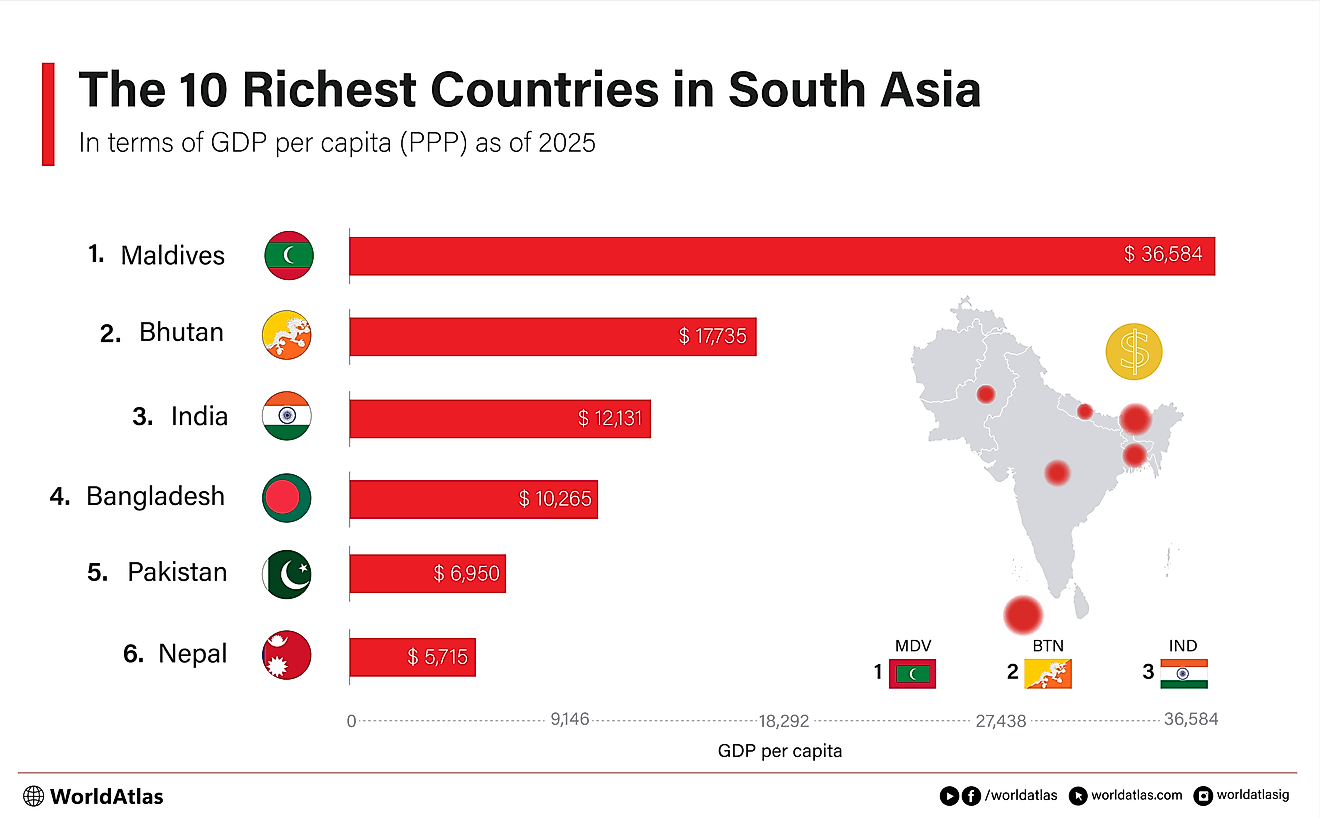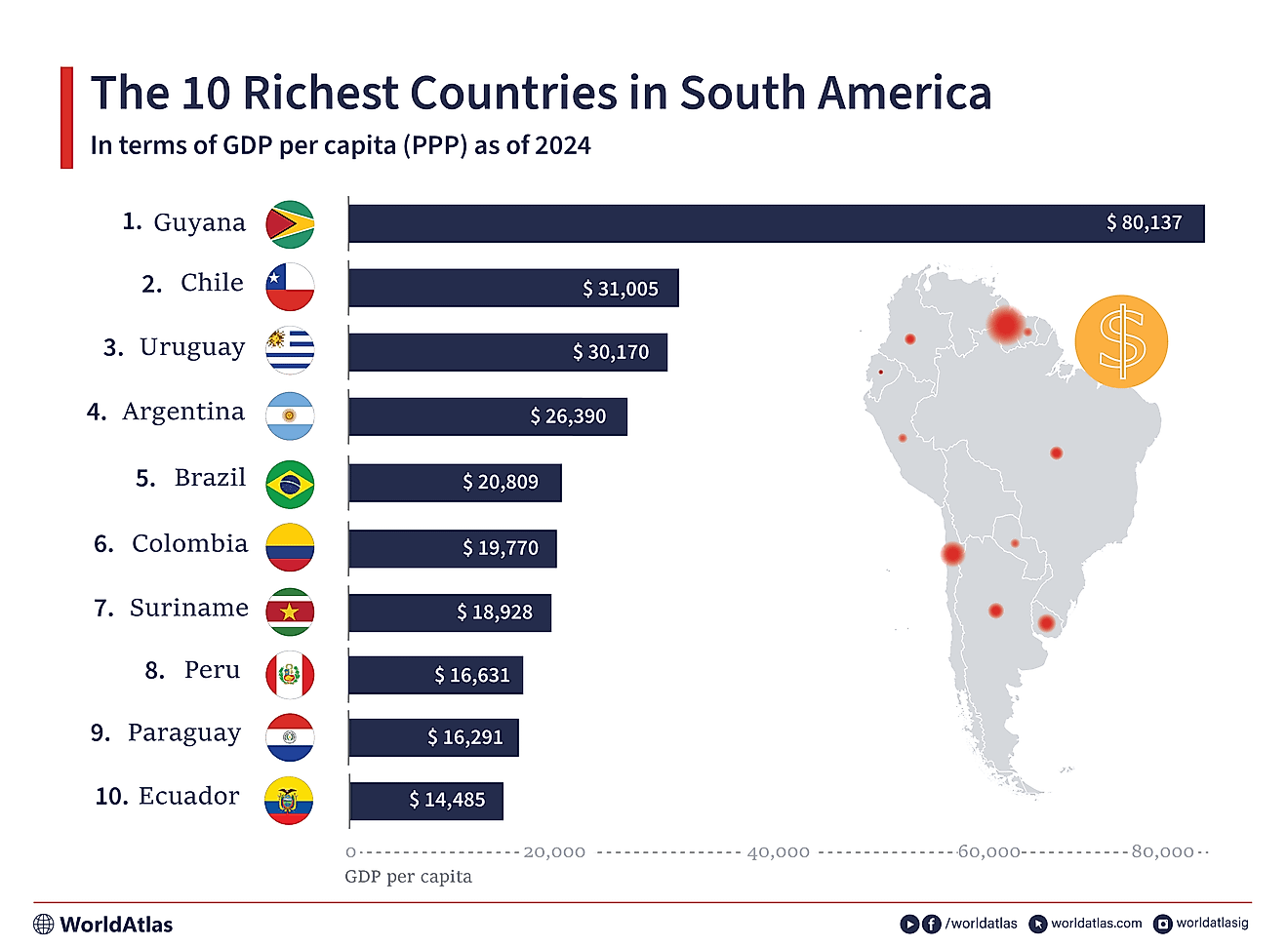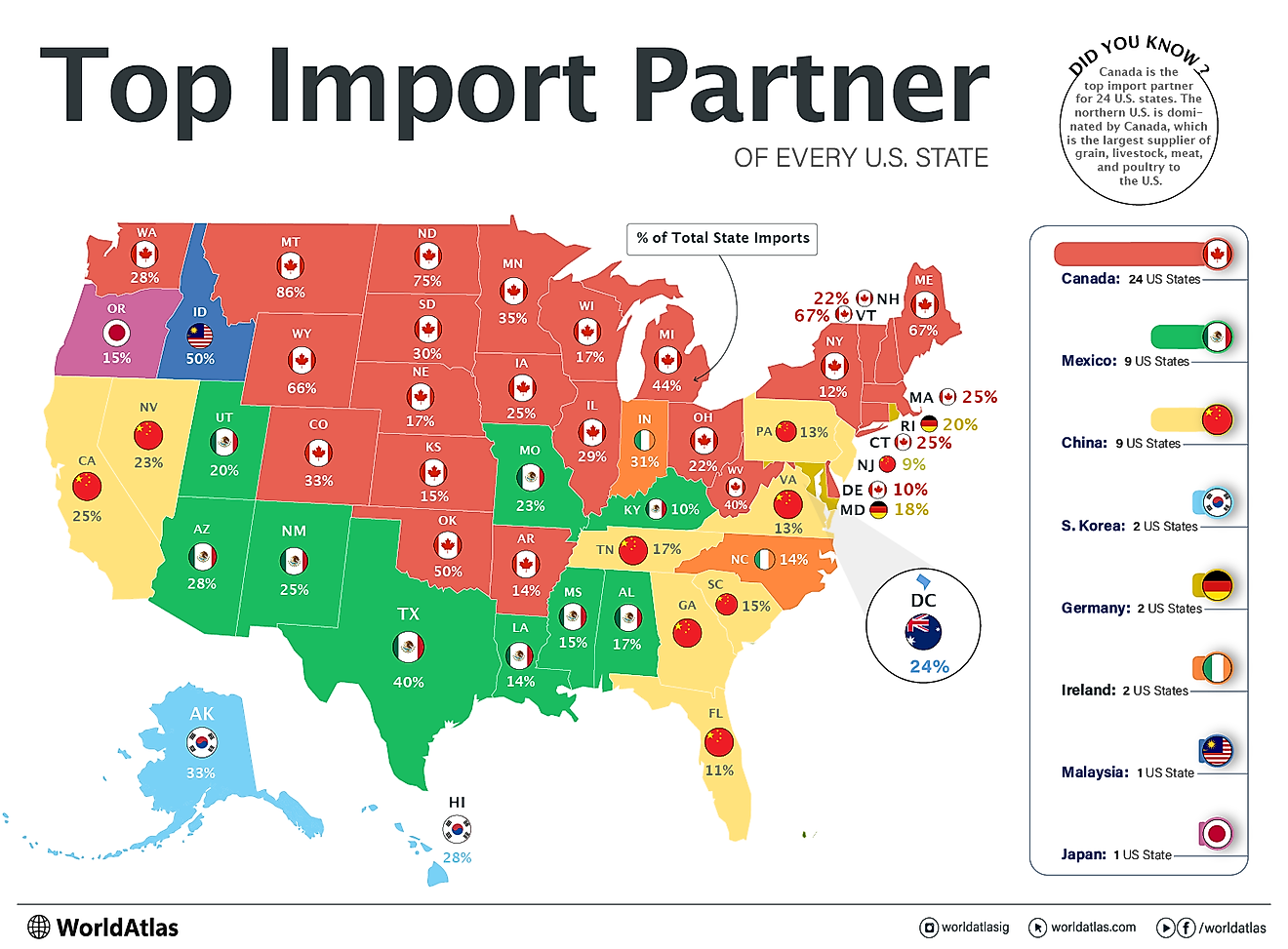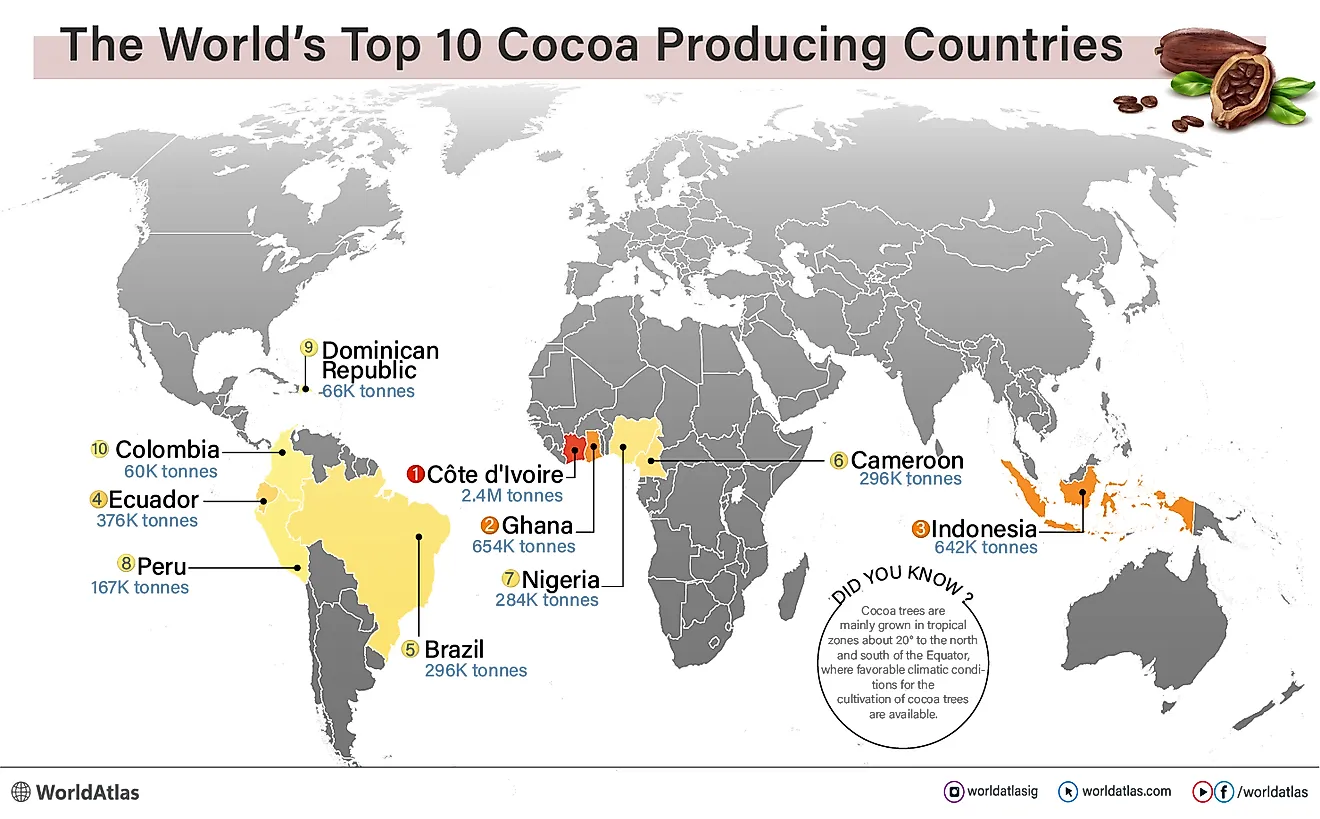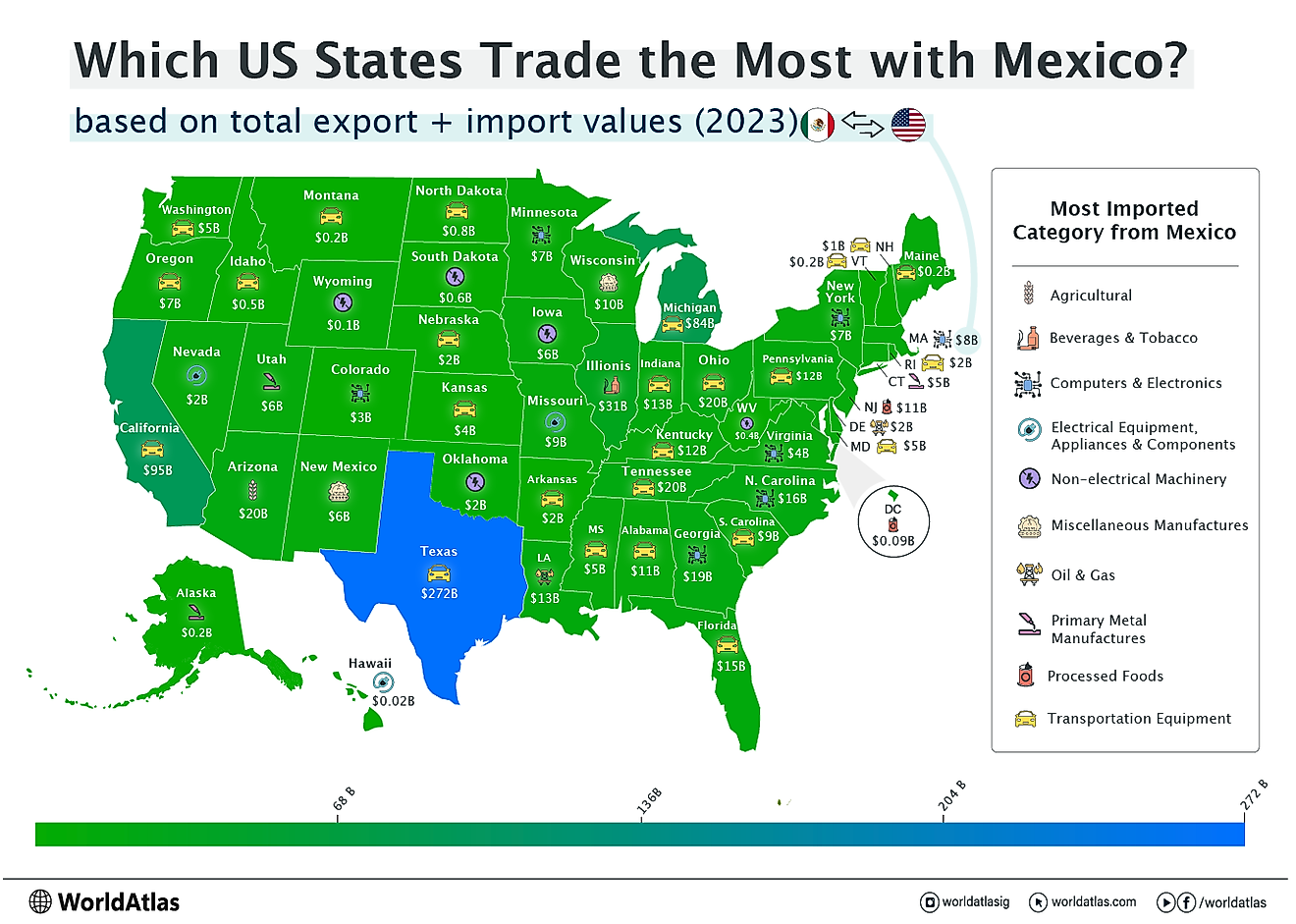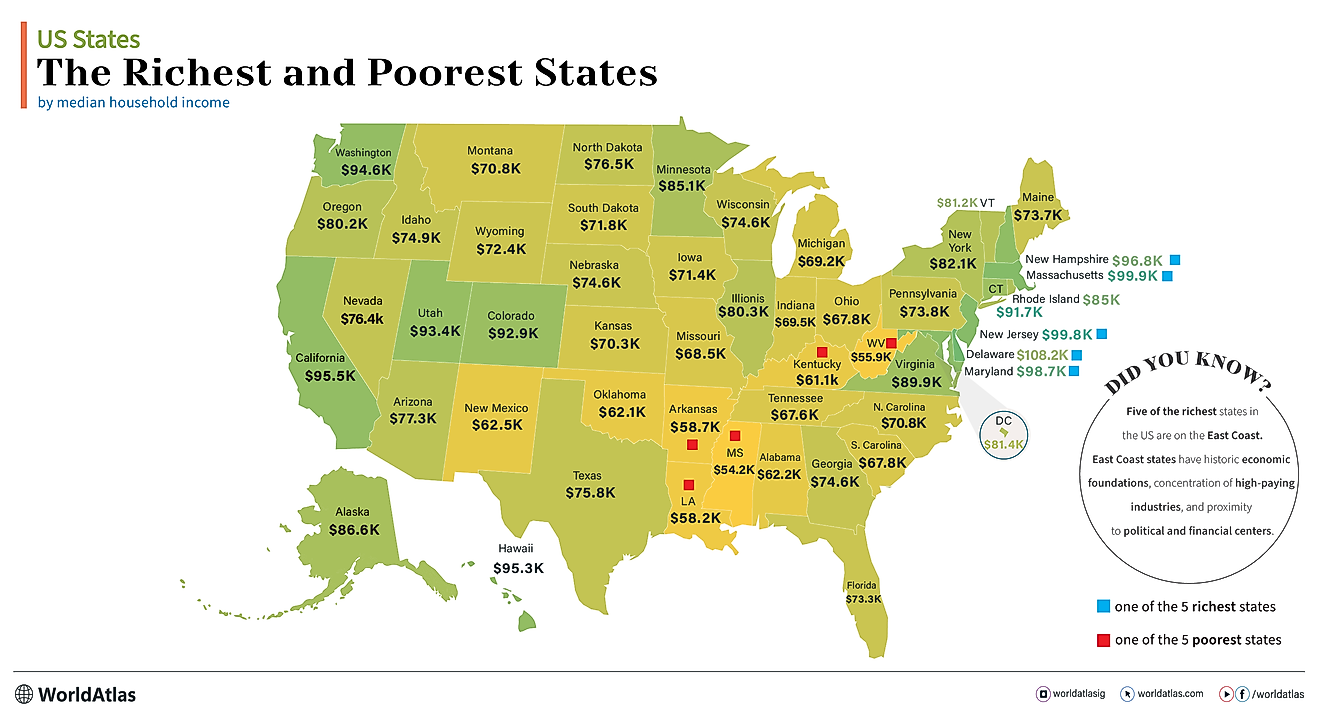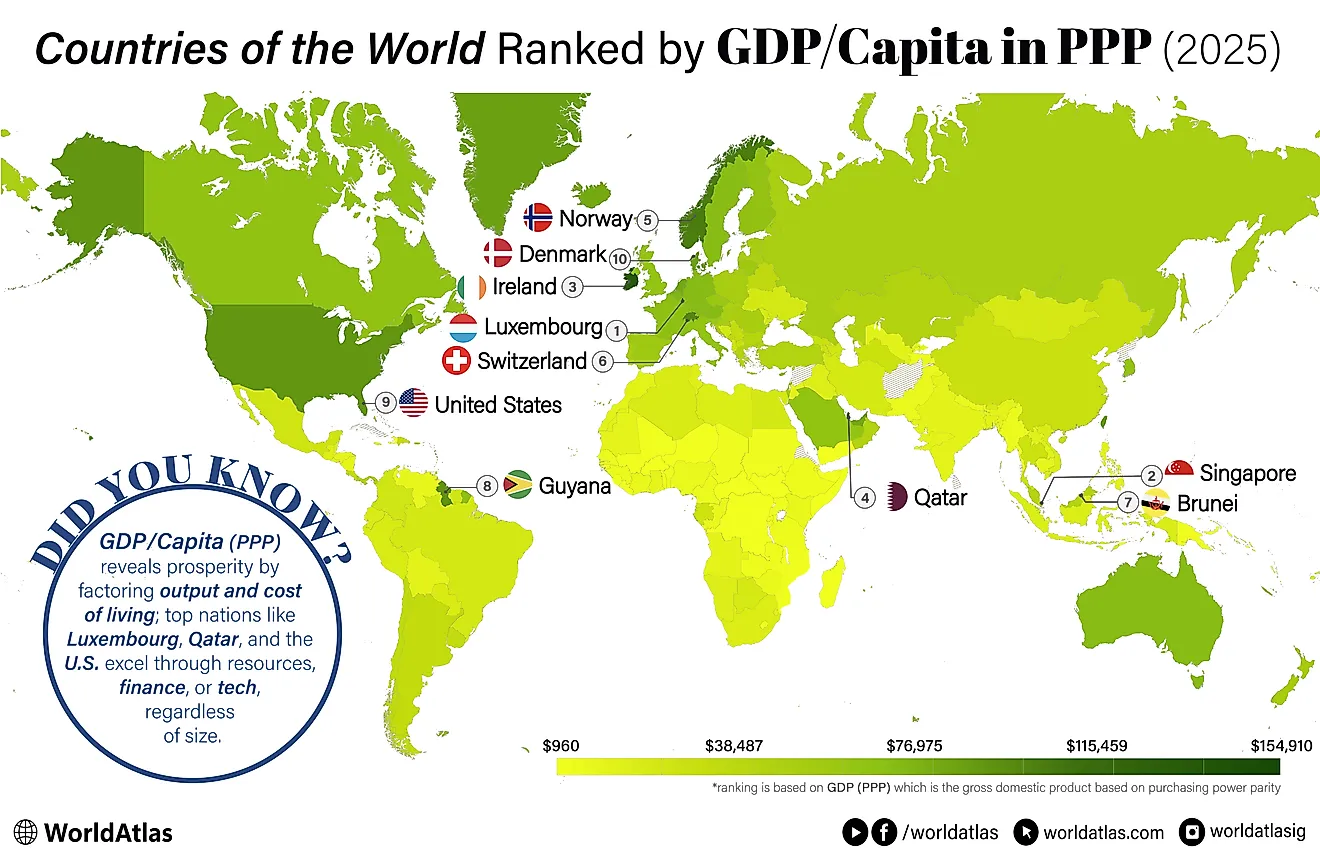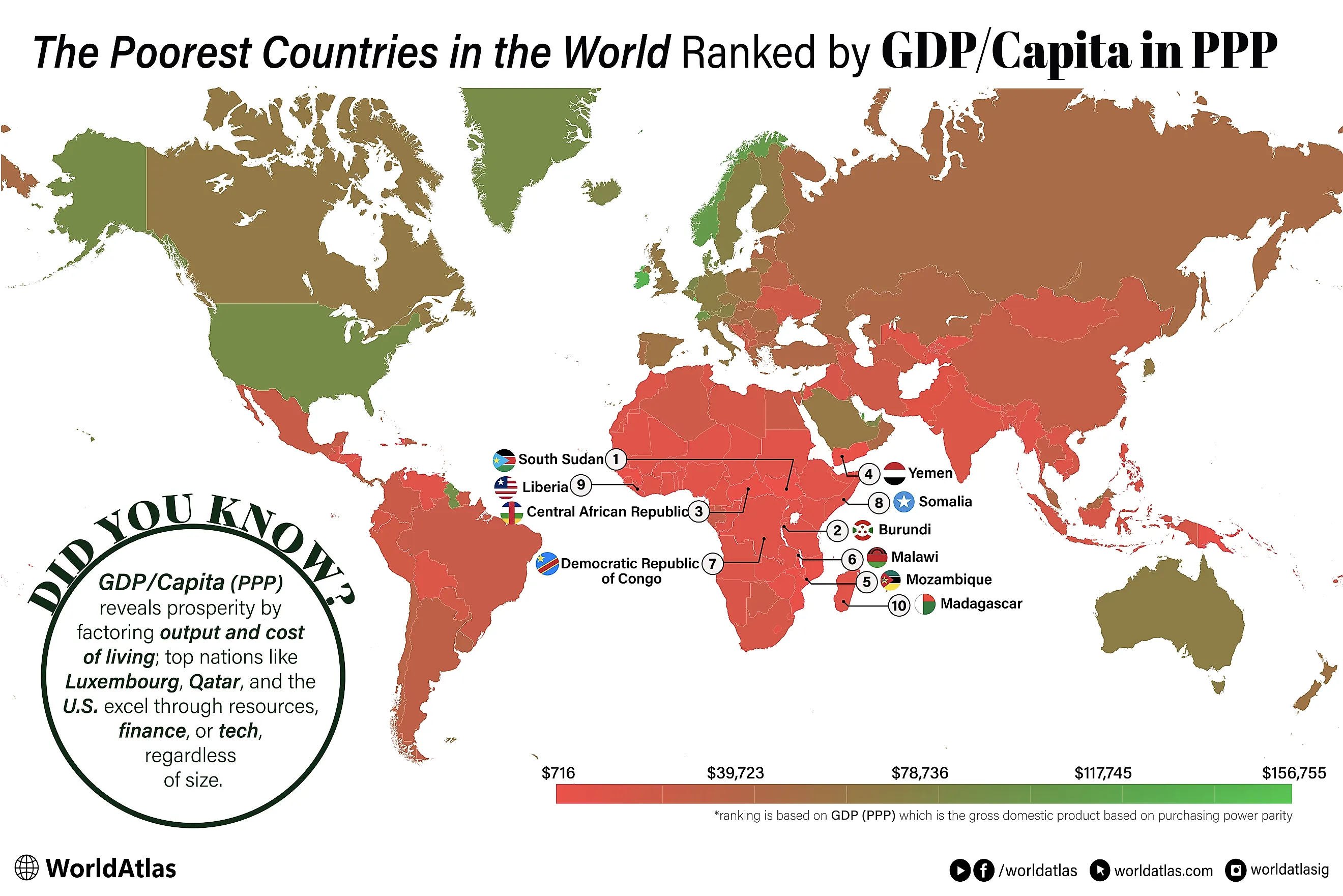
The Poorest Countries In The World 2025
When exploring a country’s standard of living, GDP per capita in purchasing-power-parity (PPP) terms can be just as revealing for poorer countries as it is for rich ones. Because it adjusts for local prices, PPP highlights how little purchasing power citizens in the world’s poorest economies actually have, even after accounting for cheaper living costs.
The nations that anchor the bottom of the IMF’s 2025 league table share a striking set of structural challenges. Many are land-locked or conflict-stricken, with limited infrastructure, fragile institutions, narrow export bases, or a heavy dependence on rain-fed agriculture. South Sudan’s prolonged civil unrest and oil-sector disruptions, Burundi’s chronic under-investment and demographic pressures, and the Central African Republic’s security crises all illustrate how political instability can suppress output and deter capital for years on end.
The following list of the ten countries with the lowest GDP per capita (PPP) for 2025 is dominated by sub-Saharan Africa. Nine of the IMF’s ten poorest economies for 2025 are African; the only outlier, Yemen, is in the conflict-wracked Horn-of-Africa/Arabian-Peninsula corridor and shares many of the same structural handicaps. South Sudan, Burundi, and the Central African Republic are the poorest countries as of April 2025, with GDP/Capita (PPP) of just $716, $1,015, and $1,330, respectively.
The 10 Poorest Countries In The World
| Rank | Country | GDP/Capita (PPP) |
|---|---|---|
| 1 | South Sudan | $716 |
| 2 | Burundi | $1,015 |
| 3 | Central African Republic | $1,330 |
| 4 | Yemen | $1,675 |
| 5 | Mozambique | $1,729 |
| 6 | Malawi | $1,778 |
| 7 | Congo, Dem. Rep. | $1,884 |
| 8 | Somalia | $1,916 |
| 9 | Liberia | $2,006 |
| 10 | Madagascar | $2,043 |
Jump to the list of all countries ranked by GDP/Capita (PPP)
1. South Sudan - $716 GDP/Capita (PPP)
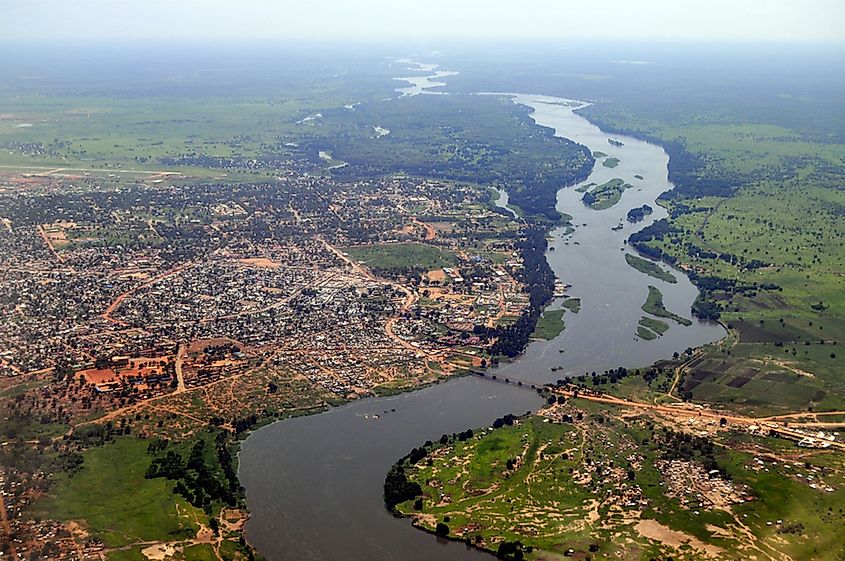
South Sudan, independent since 2011, ranks last worldwide in GDP per capita, at just $716 PPP in 2025, despite sitting on fertile land and significant oil reserves. Oil still supplies about 98 % of government revenue, but recurring civil conflict, disrupted pipelines, and depressed global prices have shrunk output and public finances. Inflation is forecast to be near 80 %, three-quarters of citizens live in poverty, and infrastructure is minimal: most roads are unpaved, and grids rarely reach outside Juba. Chronic insecurity deters investment, keeps agriculture largely subsistence-based, and forces costly food imports, deepening aid dependence, external debt, and ongoing humanitarian need.
2. Burundi - $1,015 GDP/Capita (PPP)
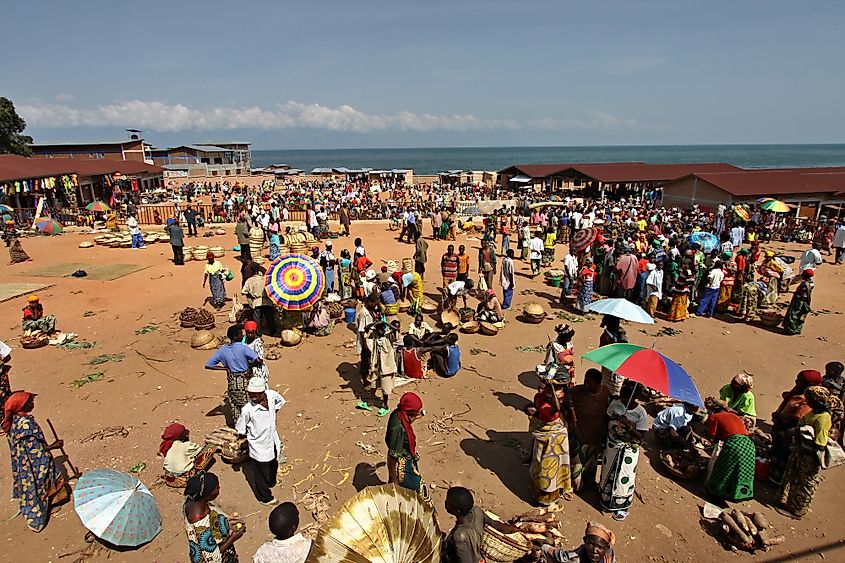
Burundi, a landlocked Great Lakes nation of 13 million, remains among the world’s poorest, with a 2025 GDP per capita of just $1,015 PPP and a nominal income below $500. Roughly 80 % of Burundians survive on small farms averaging one acre, making the economy vulnerable to climate shocks and soil erosion. Real GDP should grow 3.5 % in 2024-25, yet chronic fuel and currency shortages choke industry, while prices have driven inflation from 20 % to an expected 40 %. Only one in ten people has electricity, though new hydropower at Jiji-Mulembwe and Rusumo promises relief. External deficits and high public debt burdens and widening trade gaps persist despite aid and mining exports, while rapid population growth compounds poverty despite strides in free primary education.
3. Central African Republic - $1,330 GDP/Capita (PPP)
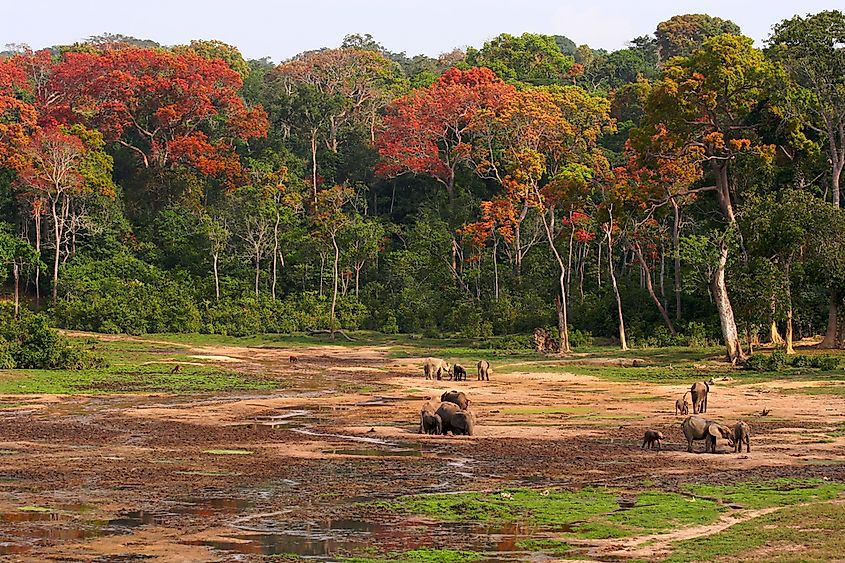
The Central African Republic (CAR), with a 2025 GDP per capita of just $1,330 PPP, remains one of the poorest nations globally. A landlocked and sparsely populated country, CAR is highly reliant on subsistence agriculture and informal trade, with 74% of the population engaged in farming. Diamonds and timber dominate exports, though much activity remains unregulated or illicit. Infrastructure is severely underdeveloped, with minimal roads, unreliable fuel supply, and limited electricity. Rich in untapped resources like gold and uranium, the economy remains stifled by insecurity, weak governance, and dependence on foreign aid. Despite modest growth projections, CAR faces steep challenges: widespread poverty, poor financial access, conflict-related damage, and underinvestment continue to hamper sustainable development and formal sector expansion.
4. Yemen - $1,675 GDP/Capita (PPP)
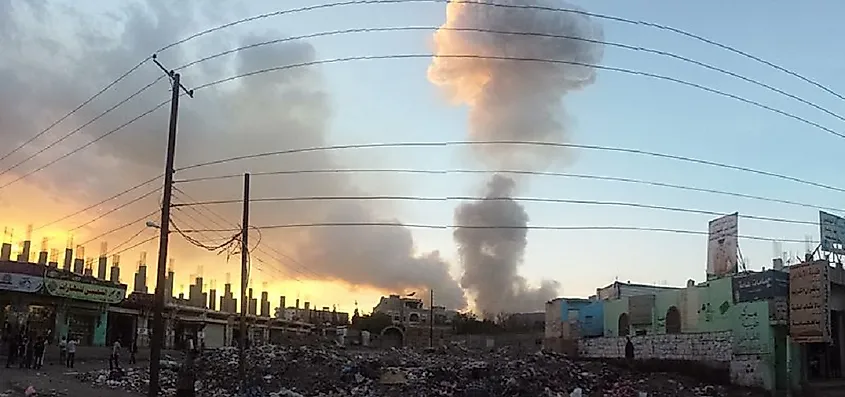
Yemen’s economy has been devastated by prolonged conflict, collapsing infrastructure, and fiscal mismanagement. With a 2025 GDP per capita of just $1,675, it ranks near the bottom globally. Oil once generated 90% of exports, but production has been crippled by war, corruption, and aging fields. Agriculture employs over half the population but is hindered by water scarcity and widespread khat cultivation, while the fishing industry remains underdeveloped. Nearly half the population lives below the poverty line, and inflation and currency devaluation have worsened living standards. Heavy dependence on foreign aid and remittances persists, yet reform efforts remain stalled. Yemen’s weak governance, humanitarian crisis, and fractured financial system continue to obstruct recovery and long-term development.
5. Mozambique - $1,729 GDP/Capita (PPP)
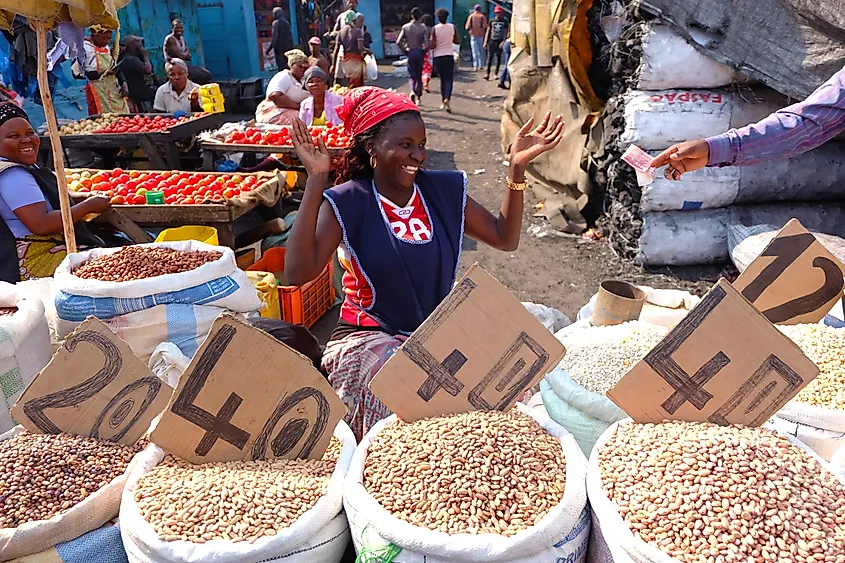
Mozambique remains one of the world’s poorest nations, with a 2025 GDP per capita of just $663 nominal and $1,730 PPP. Despite post-civil war reforms and strong GDP growth in the early 2000s, poverty and inequality remain widespread. Over 75% of Mozambicans rely on subsistence farming, and over half live below the poverty line. Agriculture, aluminum exports, and coal mining drive much of the economy, but infrastructure gaps, debt burdens, and vulnerability to climate shocks hinder progress. Foreign aid, IMF programs, and growing Chinese investment remain essential to development. While natural gas and mineral wealth offer potential, public services are underfunded, and food insecurity persists, particularly in rural areas. Recent growth has not translated into broad-based poverty reduction.
6. Malawi - $1,778 GDP/Capita (PPP)
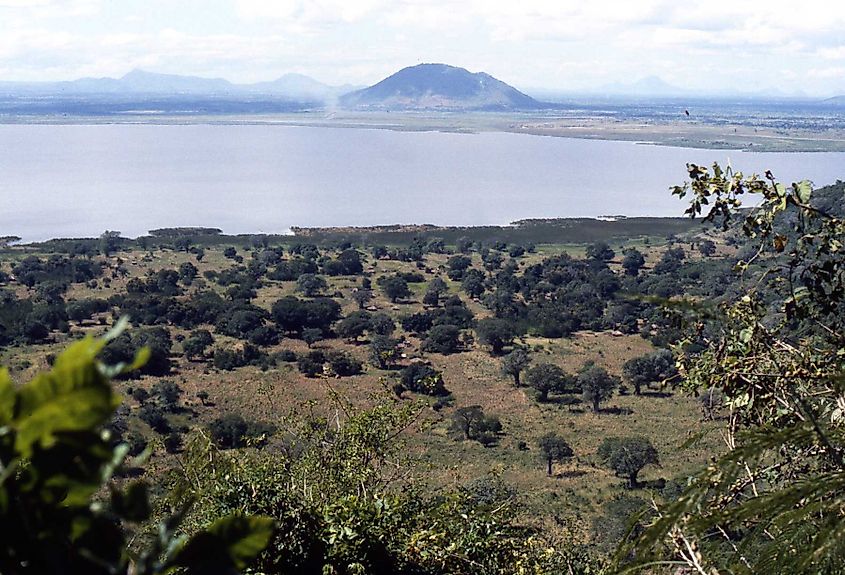
Malawi is one of the world’s poorest nations, with a 2025 GDP per capita of $1,778 (PPP). Its economy is heavily reliant on agriculture, employing nearly 77% of the labor force and accounting for about 30% of GDP. Key exports include tobacco, tea, sugar, and coffee, making the country vulnerable to global price shifts. Over half the population lives below the poverty line, and infrastructure remains underdeveloped. Malawi faces challenges such as high transport costs, deforestation, unreliable electricity, and limited access to education and healthcare. Despite economic reform efforts and foreign aid, dependence on subsistence farming, low industrialization, and climate shocks continue to hinder development and reduce resilience to poverty and external shocks.
7. Democratic Republic of Congo - $1,884 GDP/Capita (PPP)
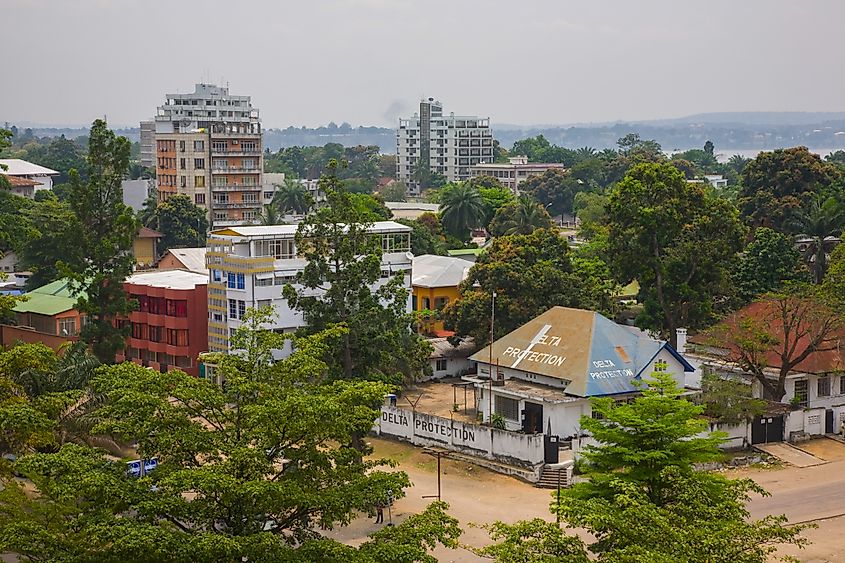
The Democratic Republic of the Congo (DRC) remains one of the world’s poorest countries, with a 2025 estimated GDP per capita of $1,884 (PPP). Despite vast mineral wealth, decades of conflict, corruption, and poor governance have stunted development. Over 76% of the population lives on less than $1.90 a day, and the country ranks among the lowest on the Human Development Index. Agriculture employs most of the workforce, while mining dominates exports, especially cobalt, copper, and diamonds. Much economic activity remains informal. Infrastructure is poor, and political instability deters investment. Though the economy has grown in recent years, poverty, malnutrition, and a lack of basic services continue to define life for most Congolese citizens.
8. Somalia - $1,916 GDP/Capita (PPP)
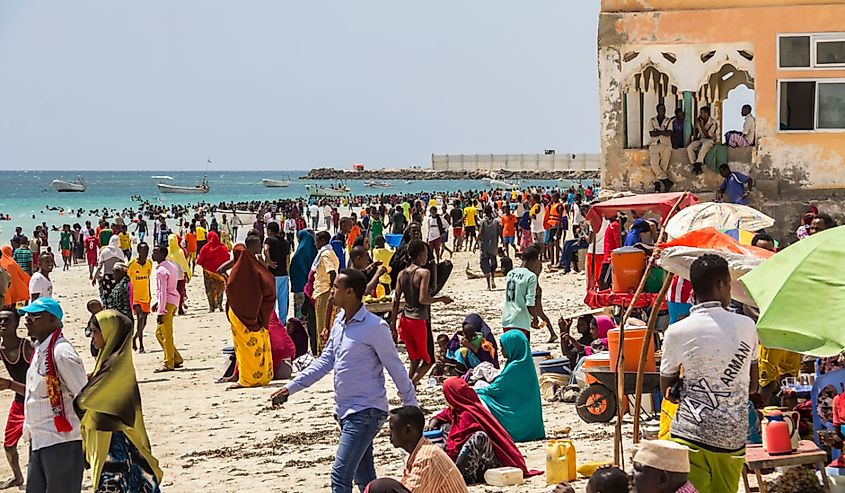
Somalia remains one of the poorest countries globally, with over 63% of its population living below the poverty line. Despite a fragile security situation and repeated climate shocks, the country has made progress in macroeconomic reform through IMF-backed programs and the Heavily Indebted Poor Countries (HIPC) Initiative. In 2024, GDP grew by 4%, driven by better rains, agriculture recovery, and rising remittances. However, high poverty, low labor force participation, especially among women, and widespread informal employment persist. Somalia’s economy relies heavily on livestock, agriculture, and remittances. Trade imbalances, a high debt burden, and declining foreign aid remain challenges. With its 2024 entry into the East African Community, Somalia has an opportunity to transition from aid dependence to regional integration and sustainable development.
9. Liberia - $2,006 GDP/Capita (PPP)
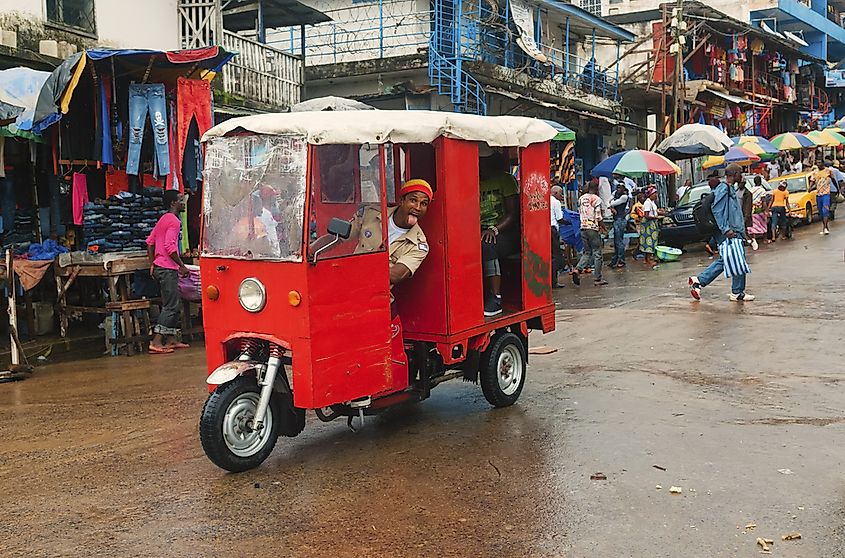
Liberia remains one of the world’s poorest nations, with 26.4% of its population living in extreme poverty as of 2024. The country is recovering from decades of civil conflict that devastated its infrastructure and economy. While GDP grew by 4.8% in 2024, driven by mining, agriculture, and services, high inflation, limited jobs, and weak social protection persist. The government, under President Joseph Boakai, is emphasizing accountability with anti-corruption reforms and a renewed development focus through the ARREST agenda (Agriculture, Roads, Rule of Law, Education, Sanitation, Tourism). Despite abundant natural resources and a strategic maritime registry, Liberia faces large trade and fiscal deficits. Sustained growth and poverty reduction hinge on governance reforms, infrastructure investment, and inclusive economic strategies targeting long-term resilience.
10. Madagascar - $2,043 GDP/Capita (PPP)
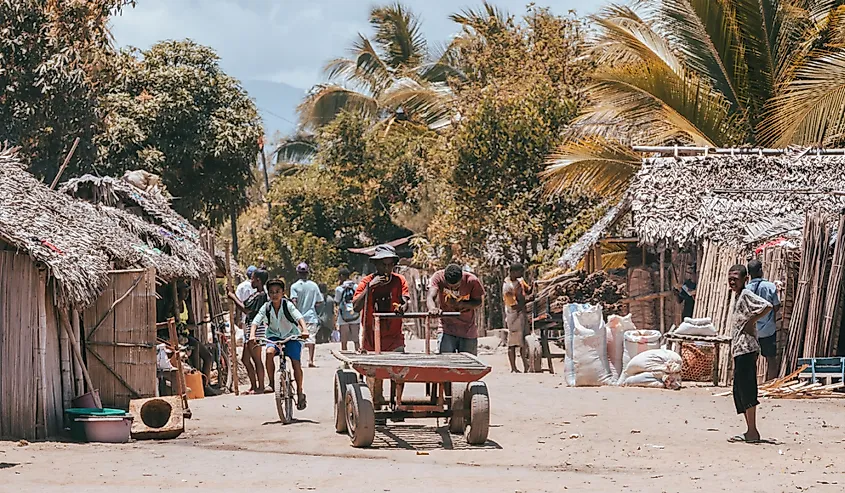
Madagascar remains one of the poorest countries in the world despite its vast natural resources and agricultural potential. With a GDP per capita of just $2,043 (PPP) in 2025 and over 75% of the population engaged in subsistence farming, poverty and underdevelopment are widespread. Agriculture dominates the economy, with Madagascar being the world’s top vanilla exporter. Political instability, notably the 2009 coup, has long deterred foreign investment and slowed economic reform. Although the country has experienced recent growth, especially in mining and textiles, income inequality, food insecurity, and child labor remain major challenges. Limited electricity access, outdated farming practices, and vulnerability to natural disasters continue to hinder progress. Madagascar’s development is constrained by fragile infrastructure, weak institutions, and persistent poverty.
Countries Ranked By GDP/Capita (PPP)
| Rank | Country | GDP/Capita (PPP) |
|---|---|---|
| - | Afghanistan | no data |
| - | Eritrea | no data |
| - | Lebanon | no data |
| - | Sri Lanka | no data |
| - | Syria | no data |
| 1 | South Sudan, Republic of | 716.249 |
| 2 | Burundi | 1015.166 |
| 3 | Central African Republic | 1329.964 |
| 4 | Yemen | 1674.74 |
| 5 | Mozambique | 1728.848 |
| 6 | Malawi | 1777.948 |
| 7 | Congo, Dem. Rep. of the | 1884.146 |
| 8 | Somalia | 1915.711 |
| 9 | Liberia | 2005.758 |
| 10 | Madagascar | 2043.021 |
| 11 | Niger | 2095.57 |
| 12 | Sudan | 2335.93 |
| 13 | Solomon Islands | 2713.251 |
| 14 | Mali | 2934.115 |
| 15 | Burkina Faso | 2978.144 |
| 16 | Vanuatu | 2986.141 |
| 17 | Chad | 2987.884 |
| 18 | Haiti | 3042 |
| 19 | Guinea-Bissau | 3278.641 |
| 20 | Lesotho | 3383.675 |
| 21 | Togo | 3473.2 |
| 22 | Sierra Leone | 3549.663 |
| 23 | Gambia, The | 3687.671 |
| 24 | Kiribati | 3707.1 |
| 25 | Papua New Guinea | 3757.173 |
| 26 | Uganda | 3896.332 |
| 27 | Comoros | 4018.225 |
| 28 | Rwanda | 4103.71 |
| 29 | Tanzania | 4370.562 |
| 30 | Ethiopia | 4397.784 |
| 31 | Zambia | 4521.845 |
| 32 | Guinea | 4749.272 |
| 33 | Micronesia, Fed. States of | 4768.245 |
| 34 | Benin | 4788.478 |
| 35 | Timor-Leste | 4915.981 |
| 36 | Zimbabwe | 5407.359 |
| 37 | Senegal | 5498.779 |
| 38 | Nepal | 5715.252 |
| 39 | Cameroon | 5759.723 |
| 40 | Myanmar | 5923.888 |
| 41 | Tajikistan | 6047.67 |
| 42 | São Tomé and Príncipe | 6422.465 |
| 43 | Congo, Republic of | 6592.972 |
| 44 | Nigeria | 6792.395 |
| 45 | Pakistan | 6950.549 |
| 46 | Tuvalu | 7005.451 |
| 47 | Kenya | 7534.003 |
| 48 | Samoa | 7621.019 |
| 49 | Marshall Islands | 7695.596 |
| 50 | Honduras | 7927.31 |
| 51 | Tonga | 8091.096 |
| 52 | Cote D'Ivoire | 8111.03 |
| 53 | Venezuela | 8397.171 |
| 54 | Ghana | 8416.501 |
| 55 | Cambodia | 8646.372 |
| 56 | Mauritania | 8653.977 |
| 57 | Kyrgyz Republic | 8780.524 |
| 58 | Nicaragua | 9106.613 |
| 59 | Djibouti | 9414.595 |
| 60 | Lao P.D.R. | 10124.67 |
| 61 | Angola | 10233.73 |
| 62 | Bangladesh | 10265.13 |
| 63 | Nauru | 11148.59 |
| 64 | Morocco | 11266.2 |
| 65 | Jordan | 11508.13 |
| 66 | Bolivia | 11574.1 |
| 67 | India | 12131.84 |
| 68 | Cabo Verde | 12254.67 |
| 69 | Namibia | 12372.99 |
| 70 | Uzbekistan | 12462.38 |
| 71 | Jamaica | 12596.68 |
| 72 | Philippines | 12934.64 |
| 73 | Eswatini | 13733.51 |
| 74 | El Salvador | 13746.21 |
| 75 | Tunisia | 14778.87 |
| 76 | Iraq | 15177.83 |
| 77 | Guatemala | 15633.57 |
| 78 | Belize | 15981.77 |
| 79 | South Africa | 15988.72 |
| 80 | Ecuador | 16577.99 |
| 81 | Fiji | 16866.95 |
| 82 | Vietnam | 17484.19 |
| 83 | Indonesia | 17611.82 |
| 84 | Bhutan | 17735.09 |
| 85 | Libya | 17757.59 |
| 86 | Palau | 18344.33 |
| 87 | Algeria | 18525.02 |
| 88 | Peru | 18688.51 |
| 89 | Botswana | 19165.74 |
| 90 | Paraguay | 19571.31 |
| 91 | Dominica | 19583.52 |
| 92 | Moldova | 19678 |
| 93 | Iran | 19957.43 |
| 94 | Equatorial Guinea | 20165.07 |
| 95 | *Kosovo | 20383.31 |
| 96 | Mongolia | 20448.43 |
| 97 | Ukraine | 20998.83 |
| 98 | Saint Vincent and the Grenadines | 21297.74 |
| 99 | Egypt | 21667.69 |
| 100 | Grenada | 21672.16 |
| 101 | Colombia | 22421.03 |
| 102 | Suriname | 22438.56 |
| 103 | Bosnia and Herzegovina | 22830.75 |
| 104 | Brazil | 23238.09 |
| 105 | Barbados | 23268.8 |
| 106 | Albania | 23404.66 |
| 107 | Gabon | 24908.24 |
| 108 | Armenia | 25059.91 |
| 109 | Mexico | 25462.86 |
| 110 | Azerbaijan | 26235.04 |
| 111 | Thailand | 26322.86 |
| 112 | Turkmenistan | 27872.8 |
| 113 | Saint Lucia | 28840.45 |
| 114 | China, People's Republic of | 28978.03 |
| 115 | North Macedonia | 29474.6 |
| 116 | Georgia | 30749.5 |
| 117 | Dominican Republic | 30874.49 |
| 118 | Argentina | 31379.49 |
| 119 | Costa Rica | 31462.66 |
| 120 | Antigua and Barbuda | 31780.62 |
| 121 | Mauritius | 32910.82 |
| 122 | Serbia | 33114.05 |
| 123 | Montenegro | 33619.8 |
| 124 | Saint Kitts and Nevis | 34001.8 |
| 125 | Belarus | 34312.69 |
| 126 | Chile | 35146.05 |
| 127 | Trinidad and Tobago | 36017.52 |
| 128 | Maldives | 36584.59 |
| 129 | Uruguay | 37060.03 |
| 130 | Bahamas, The | 38829.27 |
| 131 | Bulgaria | 41901.15 |
| 132 | Seychelles | 42009.46 |
| 133 | Oman | 42014.51 |
| 134 | Turkiye, Republic of | 42450.64 |
| 135 | Malaysia | 43473.16 |
| 136 | Panama | 43839.19 |
| 137 | Kazakhstan | 44445.67 |
| 138 | Latvia | 44563.44 |
| 139 | Greece | 45047.53 |
| 140 | Slovak Republic | 47425.38 |
| 141 | Hungary | 48600.28 |
| 142 | Romania | 49212.72 |
| 143 | Russian Federation | 49382.88 |
| 144 | Estonia | 49671.08 |
| 145 | Portugal | 50037.19 |
| * | Puerto Rico | 50772.35 |
| * | Aruba | 50895.64 |
| 146 | Kuwait | 50961.46 |
| 147 | Croatia | 51441.9 |
| 148 | Japan | 54677.12 |
| 149 | Poland | 55185.59 |
| 150 | New Zealand | 55450.39 |
| 151 | Israel | 56435.71 |
| 152 | Spain | 56554.84 |
| 153 | Lithuania | 57195.66 |
| 154 | Slovenia | 57984.88 |
| 155 | Czech Republic | 59368.14 |
| 156 | Saudi Arabia | 61922.82 |
| 157 | Italy | 63075.55 |
| 158 | United Kingdom | 63660.65 |
| 159 | Cyprus | 65088.33 |
| 160 | Korea, Republic of | 65111.9 |
| 161 | France | 65625.57 |
| 162 | Canada | 65706.53 |
| 163 | Finland | 66496.39 |
| 164 | Bahrain | 67794.59 |
| 165 | Andorra | 72059.15 |
| 166 | Australia | 72137.53 |
| 167 | Germany | 72599.01 |
| 168 | Austria | 74371.98 |
| 169 | Sweden | 74902.02 |
| 170 | Belgium | 75845.78 |
| 171 | Malta | 76705.14 |
| * | Hong Kong SAR | 77942.14 |
| 172 | Iceland | 81215 |
| 173 | United Arab Emirates | 81675.95 |
| 174 | San Marino | 83031.15 |
| * | Taiwan Province of China | 84082.04 |
| 175 | Netherlands | 84565.84 |
| 176 | Denmark | 88934.01 |
| 177 | United States | 89105.2 |
| 178 | Guyana | 94258.28 |
| 179 | Brunei Darussalam | 95758.15 |
| 180 | Switzerland | 97581.32 |
| 181 | Norway | 107892 |
| 182 | Qatar | 121605.1 |
| 183 | Ireland | 133999.5 |
| * | Macao SAR | 134042 |
| 184 | Luxembourg | 152915.4 |
| 185 | Singapore | 156755.3 |
* Macao and Hong Kong are both Special Administrative Regions of the People’s Republic of China. Taiwan Province of China is considered by the UN to be part of the PRC. Puerto Rico is an unincorporated territory of the United States. Aruba is a constituent country within the Kingdom of the Netherlands but is not a UN member. Kosovo is recognized by many states but is not a UN member (status disputed.)
